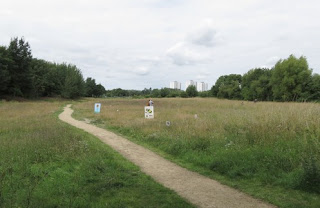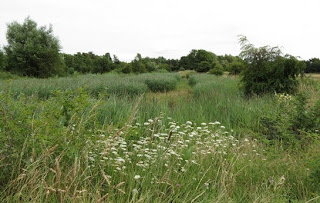 |
| Woolfall Heath Meadow |
Took a stroll last Saturday to
the community open day at Woolfall heath meadow. Woolfall Heath meadow can be
found alongside the A526, Seth Powell way L36.
Like Mab lane community woodlands
and Huyton lane wetlands, Woolfall heath is another small place with plenty of
heart. Lying alongside the River Alt,
this green patch is part of the Alt Greenway linking Huyton (The source of the Alt
has been traced to the Huyton lane wetlands site http://www.rspb.org.uk/groups/Liverpool/places/342392/ ) with Stockbridge village.
Landlife (environmental charity, founder
of and based at the National Wildflower Centre) has worked with
North Huyton Neighbourhood Network, Knowsley Council and funding partners on a
Community Spaces Project to make it more accessible, open up new pathways for
walking and cycling, do more sowings and plantings of wildflowers and trees.
 |
| Alt reedbed & wetland |
This area is now noted as potentially an ideal habitat for water voles, frogs, reed warbler and bunting, dragons and damselflies. On the day I only observed blue damselflies; time will tell if the birds and voles populate the area. I guess this will be determined by the possibility of vandalism (dreaded scrambler bikes) or the community taking it to heart, and the upkeep of the area; there was some discarded rubbish around the wetland area and the water level was low in the pond/river area, which incidentally has a new wooden viewing platform overlooking it.
 |
| View from viewing platform |
The Wildflower meadow is
framed by trees and woodland, and has a circular disabled friendly path within,
extending down to and beyond the Alt park resource centre and the playing fields.
Landlife has developed the meadow
by stripping the rich top soil to expose the subsoil, the free draining
sherdley hill sand. 16 wildflower
species were original sown however recent counts show over 100 species of native
plants are present.
i.e. devils bit and field scabious, eye bright, ragged robin, cowslip, red campion, vetch, bluebells, meadow buttercup, ox eye daisy, birds foot trefoil, wild carrot, thistle ,teasel, meadow poppy, hawkbit, cornflower, willow herb, geranium, borage, evening primrose, and nettle.
 |
| Wildflowers |
i.e. devils bit and field scabious, eye bright, ragged robin, cowslip, red campion, vetch, bluebells, meadow buttercup, ox eye daisy, birds foot trefoil, wild carrot, thistle ,teasel, meadow poppy, hawkbit, cornflower, willow herb, geranium, borage, evening primrose, and nettle.
Trees and shrubs on site are
varied include willow, poplar, oak, rowan, silver birch, buddleia, wild rose,
blackberry, elderberry.
This wildflower rich habitat
attracts a multitude of insects. Butterflies
noted within the hour I visited were Large and small white,
 |
| Peacock on scabious |
peacock, gatekeeper, meadow brown, specked w ood, small tortoiseshell, common blue and a moth 6 spot burnet. Bees included garden, buff tailed and red tailed bumblebee.

But best of all was a sound, the chirrup of grasshoppers, reminiscent of happy childhood days.
Bimo






1 comment:
Looks like old footage ,it used to be lovely there , now the alt dilted up , and view ING platform vandalized, and houses built on some of the park
Post a Comment